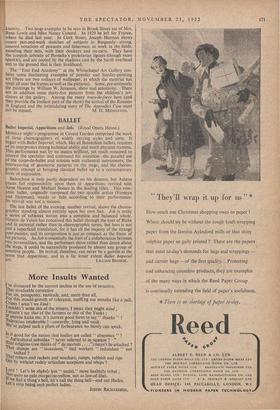BALLET
Ballet. Imperial, Apparitions and Job. (Royal Opera House.) MONDAY night's programme at Covent Garden comprised the work of three choreographers of widely varying styles and aims. It began with Ballet Imperial, which, like all Balanchine ballets, requires of its interpreters strong technical ability and much physical stamina. This performance was by no means brilliant, yet much remained to interest the spectator and command his attention—the parallel use of the corps-de-ballet and soloists with orchestral instruments; the interweaving of geometric patterns on the stage; and the choreo- graphic attempt at bringing classical ballet up to a contemporary form of expression.
Balanchine is only partly dependent on his dancers, but Ashton places full responsibility upon them in Apparitions, revived with Anne Heaton and Michael Somes in the leading roles. This rom- antic ballet, originally composed for two specific artists (Fonteyn and Helpman), stands or falls according to their performance. Its revival was not a success.
The last ballet of the evening, another revival, shows the choreo- grapher standing almost entirely upon her own feet. Job is really a series of tableaux woven into a complete and balanced whole. Ninette de Valois has conceived this ballet through the eyes of Blake and in pictorial rather than in choreographic terms, but hers is not just a superficial translation, for it has all the majesty of the strange poet-painter, and its composition is just as compact as the finest of his pictures. As Job is essentially the fruit of a collaboration between two personalities, and the performers move rather than dance about the stage, it could be successfully produced by almost any group of sensitive people. Its revival, therefore, can never be a gamble in the sense that Apparitions, and to a far lesser extent Ballet Imperial










































































 Previous page
Previous page